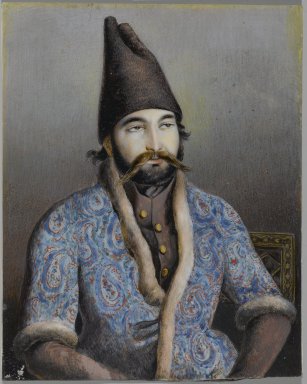
Artist:Abu'l Hasan Ghaffari, Sani' al-Mulk
Medium: Ink and opaque watercolor on ivory or shell
Geograhical Locations:
Dates:first half 19th century
Dimensions: 5 3/8 x 4 1/4 in. (13.7 x 10.8 cm)
Collections:
Accession Number: 2009.21
Image: 2009.21_PS2.jpg,
Catalogue Description: This superb miniature portrait of a nobleman displays a mastery of draftsmanship, color, and individualization associated with one of the most talented artists of the Qajar era, Abu'l Hasan Ghaffari, Sani' al-Mulk. Most remarkable is the refined execution of facial details, such as the sitter's intensely gazing eyes, his thick eyelashes, and the varied texture and coloring of his mustache, beard, and eyebrows. Abu'l Hasan is celebrated for his insightful portraiture and is remembered through numerous portrait-head studies, in which he combined his fondness for detail with the color sense of a miniature painter. Some of these were exhibited in the 1998 exhibition at the Brooklyn Museum, Royal Persian Paintings: The Qajar Epoch 1785-1925. The artist, who descended from a family of court officials, artists, and historians in Kashan, moved to Tehran in the 1820s to pursue a career in the arts. His talent brought him recognition at the court of the Muhammad Shah Qajar (r. 1834-1848), who sent Abu'l Hasan to Europe for a period to study lithography and painting. This portrait may depict Muhammad Shah in his youth. After Muhammad Shah's death, Abu'l Hasan served Nasir al-Din Shah (r. 1848-1896), who appointed him painter laureate in 1850 and awarded him the title of Sani' al-Mulk (Exalted Craftsman of the Kingdom) in 1861. The Brooklyn Museum houses the finest and largest collection of later Iranian art in the Western hemisphere. Most of the works in this collection come from the Qajar period and largely include oil paintings and lacquer ware. Ladan Akbarnia, Ph.D. Hagop Kevorkian Associate Curator of Islamic Art